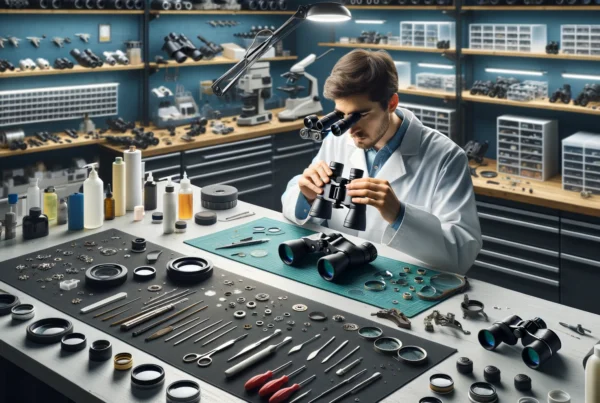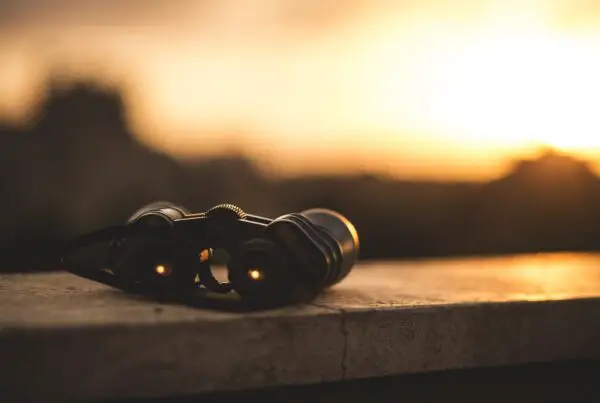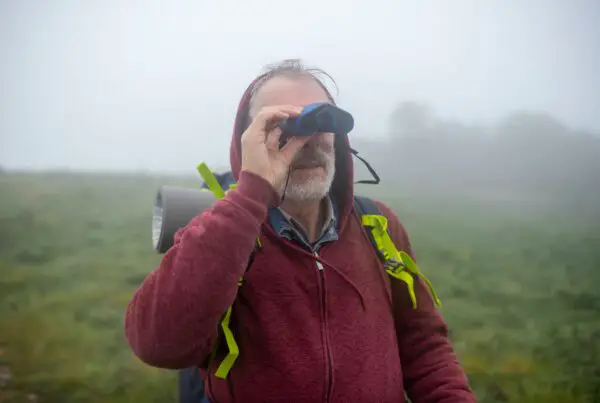Contents
- Choosing the Right Binoculars
- Setting Up Your Binoculars
- Taking Photos Through Binoculars
- Understanding the Importance of Binoculars in Landscape Photography
- Choosing the Right Binoculars for Landscape Photography
- Mastering Binocular Focusing Techniques
- Framing and Composing with Binoculars
- Capturing Unique Details and Wildlife
- Scouting and Evaluating Lighting Conditions
- Enhancing Depth of Field and Scale
- Stability and Shutter Speed
- Ethical Considerations in Landscape Photography
- Post-Processing Binocular-Enhanced Photographs
- Frequently Asked Questions (FAQs)
- Bottom Line
Ever stood on the edge of a cliff, camera in hand, and felt like the landscape sprawling out before you was just too immense to capture? I have. Or maybe you’ve found yourself squinting through your camera’s viewfinder, wishing you could get a closer look at that distant waterfall or mountain peak? Yep, been there too. That’s when I discovered a game-changing tool that’s often overlooked in the world of landscape photography: binoculars.
Now, I know what you’re thinking. Binoculars? Aren’t those for birdwatchers or stargazers? Well, sure, but these versatile optical wonders can also be a landscape photographer’s secret weapon. Imagine being able to scout out hidden details in a landscape, frame your shots with surgical precision, and even capture images through the binoculars themselves for a unique perspective. Intrigued? You should be.
In this comprehensive guide, I’ll walk you through the ins and outs of using binoculars to elevate your landscape photography to the next level. From choosing the right pair to mastering advanced techniques, get ready to see the world—and your photography—in a whole new light.
Choosing the Right Binoculars
When choosing binoculars for landscape photography, consider the magnification, objective lens diameter, and exit pupil size. Binoculars with a magnification of 7x to 10x are ideal for stargazing and viewing meteor showers.
For landscape photography, binoculars with a magnification of 8x to 12x are recommended. The objective lens diameter should be large enough to allow as much light as possible to pass through to the observer’s eyes.
Binoculars with an objective lens diameter of 42 mm or larger are ideal for landscape photography. The exit pupil size should be around 4-5 mm for viewing comets.
Setting Up Your Binoculars
Before using your binoculars for landscape photography, it’s important to set them up properly. Start by adjusting the eyecups to the proper distance from your eyes. Holding your binoculars steady is critical to spotting and following subjects efficiently.
If you’re having trouble keeping your binoculars steady, consider using a tripod or other stabilizing device.
Taking Photos Through Binoculars
If you want to take photos through your binoculars, you can align your phone camera handheld to the binoculars and take the picture. However, using a phone adaptor to mount your mobile phone to the binoculars is a better option.
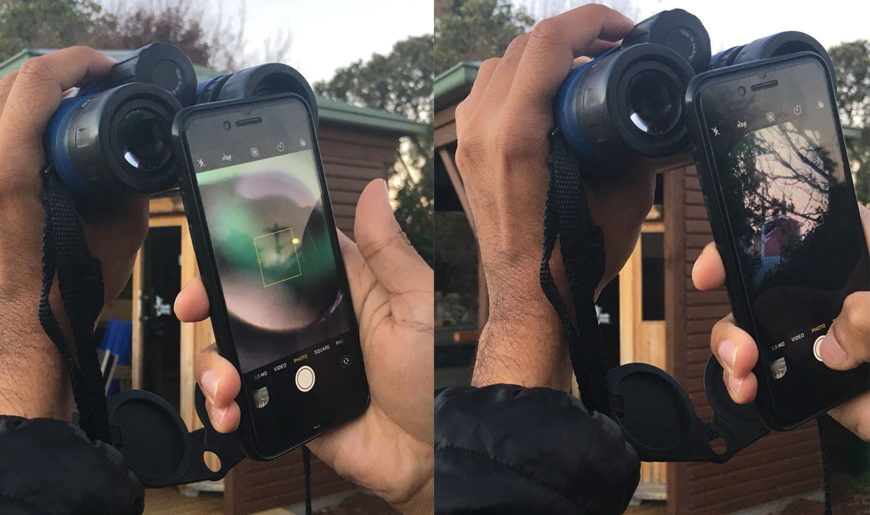
To take high-quality photos through your binoculars, mount the binoculars on a tripod and perfectly focus on the point of interest. You can also take photos of landscapes, wildlife, and more by attaching a camera to a pair of binoculars.
Understanding the Importance of Binoculars in Landscape Photography
Binoculars are not just another piece of gear; they are an extension of your vision. They allow you to explore the landscape in greater detail, spot hidden features, and identify potential subjects.
With binoculars, you can scout locations, evaluate lighting conditions, and pre-visualize compositions, saving you time and effort when setting up your camera. They enable you to see beyond what the naked eye can perceive, giving you a fresh perspective on the landscape and offering creative opportunities you may have otherwise missed.
Choosing the Right Binoculars for Landscape Photography
Selecting the right binoculars is crucial to maximize their potential for landscape photography. Consider the following factors when making your choice:
- Magnification Power: Opt for a moderate magnification power, typically around 8x. Higher magnifications may lead to stability issues, especially when hand-holding the binoculars.
- Objective Lens Diameter: A larger objective lens diameter allows more light to enter the binoculars, enhancing low-light performance and image brightness. A diameter of 42 mm is a popular choice for landscape photography.
- Field of View: A wider field of view is beneficial for quickly scanning the landscape and framing your shots effectively. Look for binoculars with a generous field of view, ideally over 300 feet at 1,000 yards.
- Optical Quality: Invest in binoculars with high-quality optics and coatings to ensure sharp, clear, and color-accurate images.
Mastering Binocular Focusing Techniques
Properly focusing binoculars is essential to fully enjoy their benefits. Most binoculars have a central focus wheel and individual eyepiece diopter adjustments. Follow these steps to achieve a sharp image:
Step 1: Close your right eye or cover the right objective lens with your hand.
Step 2: Use the central focus wheel to focus on a distant object with your left eye.
Step 3: Close your left eye or cover the left objective lens and use the diopter adjustment on the right eyepiece to focus with your right eye.
Step 4: Switch between your eyes and fine-tune the focus until the image appears sharp and clear in both eyes.
Framing and Composing with Binoculars
Binoculars are fantastic tools for honing your compositional skills. Use them to identify potential focal points, leading lines, and interesting elements in the landscape.
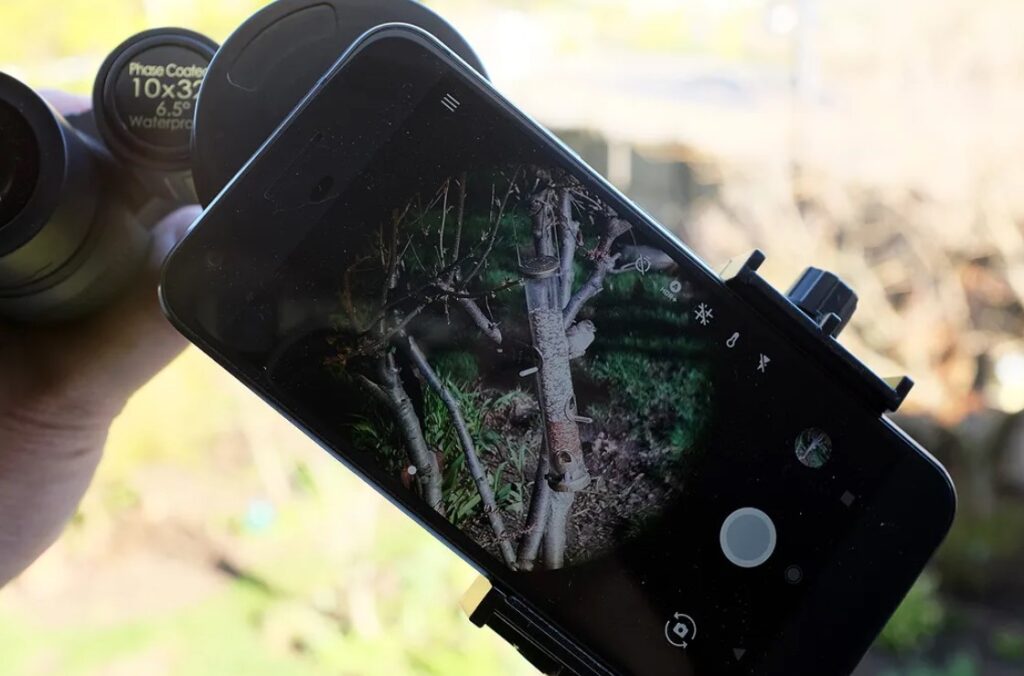
Experiment with different angles and perspectives by zooming in and out, and take note of how the elements interact within the frame. This pre-visualization process will help you create stronger compositions when you bring out your camera.
Capturing Unique Details and Wildlife
One of the most significant advantages of binoculars is their ability to reveal hidden details and distant wildlife. Zoom in on intricate textures, patterns, or interesting features, and observe how they could add depth and visual interest to your photographs.
Additionally, binoculars allow you to observe wildlife from a safe distance, without causing disturbance, making them valuable tools for wildlife and nature photography.
Scouting and Evaluating Lighting Conditions
Binoculars are a landscape photographer’s best friend when it comes to scouting locations and evaluating lighting conditions. Before you set up your camera and tripod, use binoculars to explore the area and assess how light interacts with the landscape.
Observe the play of shadows and highlights, and determine the best time of day to capture the desired mood and atmosphere.
Enhancing Depth of Field and Scale
Using binoculars can help you understand and visualize the concept of depth of field better. By observing various elements in the landscape at different distances, you can plan compositions that include foreground, mid-ground, and background elements, resulting in more dynamic and immersive images.
Additionally, binoculars allow you to emphasize distant objects, such as mountains or prominent landmarks, to add a sense of scale to your photographs.
Stability and Shutter Speed
To achieve sharp images while using binoculars, stability is crucial. If you’re using higher magnification binoculars, it’s best to mount them on a tripod to eliminate camera shake.

Additionally, consider using a remote shutter release or the camera’s timer to further reduce vibrations when taking photos. Adjust your camera’s shutter speed accordingly to accommodate any movement caused by wind or other factors.
Ethical Considerations in Landscape Photography
As you immerse yourself in the world of landscape photography with binoculars, always remember to practice ethical photography. Respect wildlife and their habitats, stay on designated trails to minimize your impact, and leave no trace of your presence.
Binoculars allow you to enjoy the beauty of nature without disturbing the delicate balance of the ecosystem.
Post-Processing Binocular-Enhanced Photographs
When processing images taken with binoculars, strive to retain the natural and authentic perspective they offer. Avoid excessive editing or manipulation that alters the original composition.
Enhance your images subtly to showcase the true beauty of the landscape as witnessed through your binoculars.
Frequently Asked Questions (FAQs)
Why should I use binoculars for landscape photography?
Binoculars offer several benefits for landscape photography. They allow you to scout locations, identify potential focal points, and evaluate lighting conditions before setting up your camera. Binoculars also reveal hidden details and wildlife, providing a fresh perspective and enhancing the overall composition of your images.
What type of binoculars should I use for landscape photography?
Opt for binoculars with a moderate magnification power, such as 8x, for a balance between a closer view and stability. A larger objective lens diameter, around 42 mm, is beneficial for better low-light performance. Look for binoculars with a wide field of view to capture more of the landscape in a single glance.
How do I focus binoculars effectively for landscape photography?
To focus binoculars, close one eye and use the central focus wheel to focus on a distant object. Then, close the other eye and adjust the diopter on the right eyepiece until the image appears sharp and clear. Switch between your eyes to fine-tune the focus until both eyes see a clear image.
Can binoculars help me find hidden details in the landscape?
Yes, absolutely! Binoculars are excellent tools for spotting hidden details, textures, and patterns in the landscape that may be overlooked with the naked eye. Zoom in with binoculars to explore these elements and incorporate them into your compositions for more compelling images.
How can I use binoculars to enhance depth of field in my landscape photographs?
With binoculars, you can identify and visualize different elements at various distances in the landscape. By planning compositions with foreground, mid-ground, and background elements, you can create a sense of depth and enhance the overall visual impact of your images.
How do binoculars help me assess lighting conditions for landscape photography?
Binoculars allow you to observe the play of light and shadow in the landscape, helping you evaluate the best time of day for capturing specific lighting conditions. By using binoculars to scout locations, you can plan your shoots and be prepared to capture the desired mood and atmosphere.
Can binoculars assist with wildlife photography during landscape shoots?
Yes, binoculars are valuable for wildlife photography during landscape shoots. They enable you to observe wildlife from a safe distance without disturbing them, allowing you to capture natural behaviors and interactions within the landscape.
Should I use a tripod with binoculars for landscape photography?
For higher magnification binoculars, using a tripod is recommended to eliminate camera shake and ensure sharp images. However, for lower magnification binoculars, handheld use is generally stable enough for landscape photography.
How can binoculars help me with composition in landscape photography?
Binoculars enable you to pre-visualize compositions and experiment with different perspectives. By identifying potential focal points and interesting elements in the landscape, you can frame your shots effectively and create more engaging compositions.
Is it ethical to use binoculars for landscape photography in nature reserves and wildlife habitats?
Yes, using binoculars for landscape photography in nature reserves and wildlife habitats is ethical. Binoculars allow you to enjoy and appreciate the beauty of nature without causing any disturbance to wildlife or their habitats. Always follow ethical guidelines and practice responsible photography to minimize your impact on the environment.
Bottom Line
We’ve journeyed through the overlooked yet fascinating world of using binoculars in landscape photography. From scouting out the perfect vantage point to zooming in on those intricate details that make a landscape truly come alive, binoculars have proven to be more than just a birdwatcher’s toy. They’re a bona fide tool in our photography arsenal.
If you were skeptical at the start, I don’t blame you. I was too. But after integrating binoculars into my workflow, I’ve found that they open up a new realm of possibilities. They allow me to see the world in greater detail, help me plan my shots more effectively, and even offer a fresh, zoomed-in perspective that’s hard to achieve otherwise.
So the next time you find yourself standing in awe of a sprawling landscape, wishing you could capture its grandeur and its details, remember that a pair of binoculars might just be the secret ingredient you’ve been missing. Give it a try; you might be surprised at the magic you can create.

A Binoculars enthusiast, who love exploring skies and watching birds. It is my hobby to collect Binoculars of different kinds and try to explore the world through various lenses. This is all I do to explore happiness by magnifying my beautiful world.


